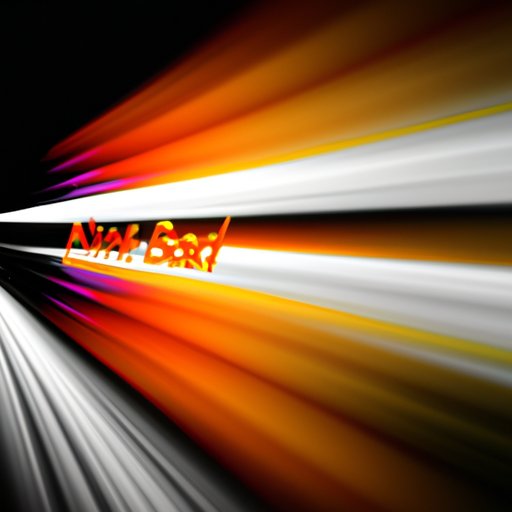Introduction
The speed of light is one of the most fundamental physical constants in the universe. According to Albert Einstein’s Theory of Relativity, nothing can travel faster than the speed of light. This has been a widely accepted scientific principle for over a century, but recent developments in physics have led some scientists to question whether it is possible to break the speed of light barrier.
Exploring the Theory of Relativity and Its Implications for Faster-Than-Light Travel
The Theory of Relativity states that the speed of light is constant regardless of the observer’s relative motion. This means that no matter how fast an object is moving, the speed of light will always remain the same. This theory has profound implications for our understanding of the universe and has led some scientists to consider the possibility of breaking the speed of light barrier.
How the Theory of Relativity Affects the Speed of Light
The Theory of Relativity states that the speed of light is an absolute maximum, meaning that nothing can travel faster than it. This is because as an object approaches the speed of light, its mass increases exponentially. At the speed of light, an object would become infinitely massive and therefore unable to accelerate any further.

The Possibility of Breaking the Speed of Light Barrier
Despite the apparent impossibility of surpassing the speed of light, some scientists believe that there may be ways to do so. These theories involve manipulating space-time in order to create shortcuts or “wormholes” that would allow objects to travel faster than the speed of light. Other possibilities include using exotic forms of propulsion such as warp drives or antimatter engines.

Examining Proposed Methods of Traveling Faster Than the Speed of Light
Warp drives are hypothetical engines that use warped space-time to propel an object faster than the speed of light. These drives work by creating a bubble of curved space-time around the object, allowing it to move at speeds that exceed the speed of light. While the technology required to create a warp drive is far beyond our current capabilities, some scientists believe that it is theoretically possible.
Wormholes are another proposed method of faster-than-light travel. They are hypothetical tunnels in space-time that connect two points in the universe, allowing an object to travel between them instantaneously. While wormholes have yet to be proven to exist, they are often used as a plot device in science fiction stories.
Other theoretical possibilities include using dark energy or negative mass to propel an object faster than the speed of light. However, these ideas remain largely speculative and have yet to be tested in the laboratory.

Reviewing Recent Scientific Discoveries on the Subject
In recent years, several studies have been conducted on the possibility of faster-than-light travel. In 2019, researchers from the University of Leicester found evidence that particles called neutrinos could travel faster than the speed of light. However, this finding was later disproved due to an error in the experiment.
Other studies have compared the speed of light to other forms of propulsion. For example, a 2020 study from the University of Cambridge found that light travels faster than sound and electrical signals. This suggests that while the speed of light may be an absolute limit, there are still ways to travel faster than conventional forms of propulsion.
Discussing the Impact of Faster-Than-Light Travel on Our Understanding of the Universe
If it were possible to travel faster than the speed of light, it would have a profound impact on our understanding of the universe. For one, it would open up the possibility of interstellar travel, allowing humans to explore distant star systems. It would also make communication between planets much easier, potentially revolutionizing intergalactic commerce and diplomacy.
Faster-than-light travel would also have implications for our understanding of time and space. If objects were able to move faster than the speed of light, it would mean that the laws of physics as we know them would no longer apply. This could lead to new discoveries about the nature of the universe and our place within it.
Conclusion
The speed of light is one of the most fundamental constants in the universe, and according to Einstein’s Theory of Relativity, nothing can travel faster than it. Despite this, some scientists believe that it may be possible to break the speed of light barrier through the use of warp drives, wormholes, or other theoretical methods. Recent scientific studies have explored the possibility of faster-than-light travel, and their findings suggest that there may be ways to travel faster than conventional forms of propulsion.
If it were possible to travel faster than the speed of light, it would have a profound impact on our understanding of the universe. It could open up the possibility of interstellar travel and revolutionize intergalactic commerce and diplomacy. Ultimately, it is still unclear whether it is possible to travel faster than the speed of light, but the implications of such a discovery would be immense.
(Note: Is this article not meeting your expectations? Do you have knowledge or insights to share? Unlock new opportunities and expand your reach by joining our authors team. Click Registration to join us and share your expertise with our readers.)
